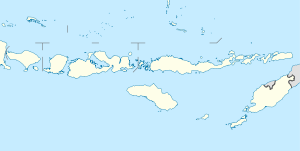West Amanuban
| Kecamatan Amanuban Barat West Amanuban District
|
|
|---|---|
 |
|
| Basic data | |
| Country | Indonesia |
| province | East Nusa Tenggara |
| Administrative district | South Central Timor |
| Seat | Zero |
| surface | 114.3 km² |
| Residents | 22,820 (2017) |
| density | 200 inhabitants per km² |
| ISO 3166-2 | ID-NT |
| Residential hut in West Amanuban (1990) | |
Coordinates: 9 ° 54 ′ S , 124 ° 19 ′ E
West Amanuban ( Indonesian Amanuban Barat ) is an Indonesian district ( Kecamatan ) in the west of the island of Timor .
geography
| "Village" (Desa) | Administrative headquarters | surface | Residents | Population density |
|---|---|---|---|---|
| Tubuhue | Tubuhue | 9.74 km² | 2,755 | 247 |
| Haumenibaki | Haumenibaki | 10.07 km² | 1,192 | 103 |
| Mnelalete | Mnelalete | 12.90 km² | 6,756 | 459 |
| Pusu | Pusu | 5.76 km² | 1,617 | 246 |
| Zero | Zero | 29.47 km² | 3,584 | 106 |
| Tublopo | Tublopo | 12.99 km² | 2,293 | 154 |
| Nusa | Nusa | 12.20 km² | 2,316 | 166 |
| Nifukani | NIfukani | 6.89 km² | 2,307 | 293 |
Location in East Nusa Tenggara Province
|
The district is located in the west of the administrative district of South Central Timor (Timor Tengah Selatan) of the East Nusa Tenggara Province (Nusa Tenggara Timur) . In the southwest is the district of South Amanuban (Amanuban Selatan) , in the east Batu Putih , in the north South Molo (Molo Selatan) and Kota Soe , in the northeast Kuatnana and in the south Noebeba .
West Amanuban has an area of 114.30 km² and is divided into the eight Desa Tubuhue , Haumenibaki , Mnelalete , Pusu , Nulle , Tublopo , Nusa and Nifukani . The administrative headquarters are in Nulle. The Desa are again divided into a total of 27 Dusun (sub-villages). While Haumenibaki is at an altitude of 515 m , Nusa is at an altitude of 831 m above sea level. As in Timor, the tropical climate is divided into a rainy and a dry season . January and February are the rainiest months, while July to December are drier. In 2017 there were 69 rainy days and a total of 875 millimeters of precipitation was recorded. In 2016 there were 97 rainy days and 2098 millimeters.
flora
Among other things, teak can be found in the district .
Residents
In 2017, West Amanuban had a population of 22,820. 11,402 were men and 11,450 were women. The population density was 200 people per square kilometer. 7.30 percent of the population profess the Catholic faith, 88.34 percent are Protestants, 4.34 percent are Muslim and 0.02 percent are Hindus. There are three Catholic and 35 Protestant churches and chapels in the district.
Economy, infrastructure and transport
Most of the district's residents make a living from agriculture. Cattle (5,261), buffaloes (five), pigs (6,276), goats (850) and chickens (44,479) are kept as pets. Maize is grown on 3,080 hectares, rice on 29 hectares, manioc on UBI KAYU, sweet potatoes on 808 hectares and peanuts on 15 hectares. Other agricultural products include onions, cabbage, Indian mustard, beans, chilli, tomatoes, cucumbers, pumpkins, spinach, avocados, mangoes, tangerines, oranges, guavas, papayas, bananas, apples and jackfruits. For example, coconuts, coffee, cocoa and vanilla come from plantations.
West Amanuban has 17 elementary schools, six middle schools and two secondary schools. A community health center ( Puskesmas ) in Tublopo, two medical care centers ( Puskesmas Pembantu ) and a midwifery center ( Polindes ) are available for medical care .
ASPAL kilometers of roads are paved. KERIKEL kilometers of roads are covered with gravel. Simple clay slopes in the district have a length of TANAH kilometers. Public transport is operated by MIKROLET minibuses, PICKUP pick ups, TRUK trucks, BIS buses, OJEKMOTOR motorcycles and other LAINYA vehicles.
Web links
- Statistical data from West Amanuban District 2018 (Indonesian).


